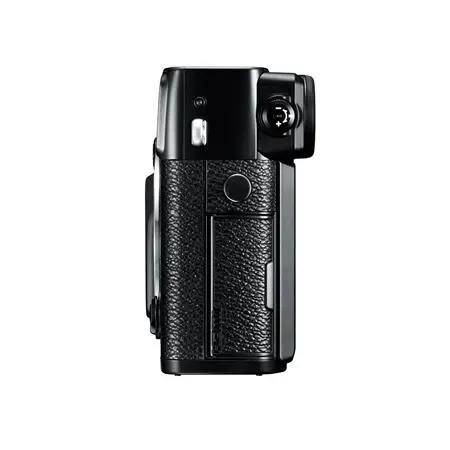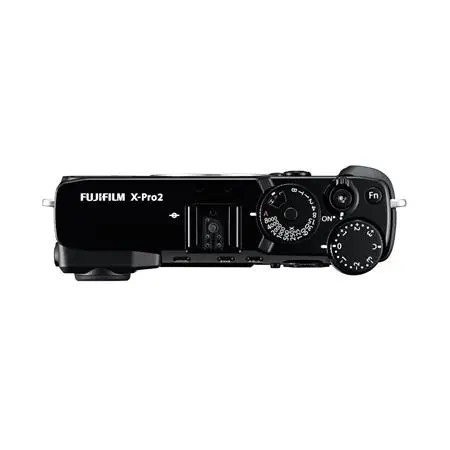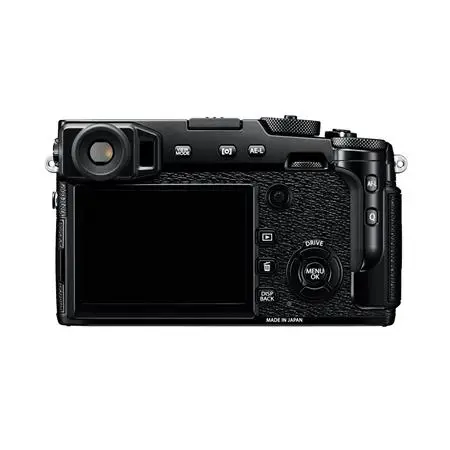The Fujifilm X-Pro2 is an interchangeable lens mirrorless “rangefinder” style camera that has both optical and electronic viewfinders. It’s also the first mirrorless camera of which I know that has two card slots, which is mandatory for use as backup for any professional use. Neither Sony nor LEICA are there yet; with only one card slot these other cameras are fun, but not suitable for any professional use where you absolutely, positively need to get your photos.
The XPro2 is a huge update from the now primitive X-Pro1 of 2012. This X-Pro2 is Fuji’s best camera if you want an interchangeable lens mirrorless camera and need both electronic and optical viewfinders.
I don’t find the optical finder very useful since EVFs today are real-time, and the electronic finder (EVF) isn’t very good when compared to Sony’s far superior EVFs. A huge problem with the X-Pro2’s EVF is that it’s rarely the correct brightness. It’s usually too dark indoors, and sometimes too bright, in Auto brightness mode. In Manual brightness mode, it’s never the right brightness as you move around. Sony’s EVFs just work, while I’m always cursing at this Fuji’s EVF.
I prefer Fujifilm’s X-T10 which adds a built-in flash. It weighs less, too. The X-T10 skips the optical finder and otherwise has the same practical performance as this X-Pro2 — for less than half the price.
If you want a tough, well-made camera and don’t need an optical finder (you don’t), I prefer the X-T1, and it also costs much less. I’m serious; if I have all three on my shelf, I grab the X-T10, and if not the X-T10, I’d grab the X-T1 before I took the X-Pro2. I don’t like the X-Pro2 compared to the others; it weighs more and certainly doesn’t work any better.
The X-Pro2 is especially popular with hobbyists who appreciate a mechanically well-made camera. This X-Pro2 has the best mechanics of any camera coming out of the Orient today. The main reason to get an X-Pro2 is if how a camera feels in your hand is more important than how well it takes pictures. The X-Pro2 is for people whose work isn’t yet good enough to warrant the ownership of the LEICA system, but still want a camera that feels well-made.
I’m not impressed with the X-Pro2. Its Auto-Area AF system works so poorly so I have to assign AF points manually, it won’t focus well in very dark conditions, and its EVF is poor because it’s often too dark or too bright.
The X-Pro1 was extremely innovative in its day, but it had its weirdnesses. Sadly the X-Pro2 retains all the quirkiness of the X-Pro1, and simply piles-on more features without bothering to organize any of them, so it’s even harder to figure out and shoot. I was hoping that Fuji would spend its efforts streamlining its interface, while instead it just threw more garbage on the feature pile. For instance, while the ISO dial is nice, both ISO 51,200 and ISO 25,600 come up at the “H” setting; you have to select which one you get in a menu! You have to press MENU > wrench menu > button/dial setup > ISO dial setting (H) > 12,800 or 51,200, which is not easy to do when you’re under pressure in the dark. The X-Pro2 does a lot of dumb things that I no longer will tolerate now that Sony has come out with better cameras that weren’t around back in 2012; the world has moved on.
Quirkiness was cute back in the day when the X-Pro1 was novel and we expected Fuji to iron out the quirks. Sadly today instead of refining the X-Pro, Fuji simply piled more features on top of the existing mess.
Fuji has a history of adding even features via firmware updates, even retroactively to old models. This is fantastic for hobbyists since the camera you buy today will be even better in a year, but useless for those of us to have to produce photos today in order to eat today. I can’t make a picture today with a firmware update that arrives tomorrow.
As expected, this Fuji’s skin tones are awesome in any light, and OK for nature and landscapes. Use these Fujis for people pictures, but don’t get a Fuji if people aren’t most of what you shoot.
New
● Two SD card slots, a first in mirrorless as far as I know.
● The color saturation adjustment now goes to ± 4 from ± 2. I shoot at +4, and shoot my other Fujis at their maximum of +2. I seem to be able to get more vivid colors from my X-Pro2 than I can from my other Fuji cameras, all as-shot as JPGs.
● A new thumb nubbin makes it easier to select AF areas and to scroll around playback images.
● Adjustable diopter on the viewfinder like every other camera in the past 20 years; the old X-Pro1 needed fixed diopters — even for normal vision!
● Optical finder has different magnifications to set itself to different ranges of lenses, just like a 1990s 35mm point-and-shoot.
Good
● Superior all-metal construction.
● Produced domestically in Japan.
● Almost all the buttons are on the right, so it’s easy to shoot with only one hand.
● Great skin tones in any light.
● Super-sharp sensor.
● AF areas cover most of the sensor.
● Direct, dedicated shutter, exposure mode, compensation, ISO and often aperture dials.
● Has a silent electronic shutter mode, and even the standard mechanical shutter mode is quiet and refined.
● Wi-Fi.
Bad
● Crummy electronic viewfinder by 2016 standards; Sony has left Fuji in the dirt. It’s sharp, but this Fuji’s EVF is usually too bright or too dark to see well.
● Surprisingly poor low-light autofocus. Would have been OK in 2005, but you can’t focus on people when it gets dim in a restaurant without an AF illuminator. Most other cameras, even the Sony RX10 Mk III, have no problem with this today.
● Unusable Auto AF-Area selection. You have to select an AF sensor manually; otherwise in Auto AF-Area mode the X-Pro2 rarely finds the subject and usually focuses on the background! The Fuji X100T is far better here; I have no idea how Fujifilm could have screwed this up.
● ● Obtuse menu and control system. Even the most basic settings like the clock or formatting are hidden at MENU > Wrench > USER SETTING > Date/Time. Screen brightness is at MENU > Wrench > Screen Setup. Good luck trying to find anything unless you shoot every day.
Missing
● No flash.
● No GPS.
● Auto ISO can’t be programmed for minimum shutter speed to track lens focal length; has manual slowest-speed settings only.
● No real preset modes; the “Custom Settings” only store and recall a very limited subset of parameters.
● No touch screen.
● No RGB histogram, but not needed because the X-Pro2 does so well at handing highlight overload.
● Only a one-axis level for roll (“Dutching” or left-right tilt); no second axis for pitch (up-down).
● No deeper zero detent on the exposure compensation dial makes it impossible to find Zero quickly by feel.
● Tiny exposure compensation display in the finder means you could shoot an hour before you realize you’re at +1 stop from last night.
● No battery percentage in finder, just a bar. (You can see percentage on the rear LCD.)
● Charges only by taking battery out and putting in a separate charger; can’t charge via USB.
Lens Compatibility
It uses only Fuji’s X-mount lenses, which are excellent.
Zeiss makes some lenses for the X-mount as well.
You can use adapters to use just about any other kind of lens, but I don’t recommend this since its hokey and Fuji’s own lenses are so good. Don’t buy this expecting to use the other lenses you already have; plan on buying all new Fuji lenses or you’re wasting your time.
Specifications
Image Sensor
24 MP.
No low-pass (anti-alias) filter; special random-distribution color-filter array eliminates the need for it.
15.6 x 23.6 mm.
1.5:1 aspect ratio.
1.53x crop factor.
Image Sizes
Native: 4,000 x 6,000 pixels (24 MP).
Medium: 4,240 x 2,832 (12 MP).
Small: 3,008 x 2,000 (6 MP).
Cropped Aspect Ratios
16:9 or square crops from the above:
Large
16:9: 6,000 x 3,376 (20 MP).
Square: 4,000 x 4,000 (16MP).
Medium
16:9: 4,240 x 2,384 (10 MP).
Square: 2,832 x 2,832 (8 MP).
Small
16:9: 3,008 x 1,688 (5 MP).
Square: 2,000 x 2,000 (4 MP).
Dynamic Range Modes
AUTO (100% or 200%),
Manual: 100%, 200% or 400%.
200% only works with ISO 400 or above.
400% only works at ISO 800 or above.
Crazy “Film” Modes
PROVIA / Standard
Velvia / Vivid
ASTIA / Soft
CLASSIC CHROME
PRO Neg. Hi
PRO Neg. Std
ACROS/ Black & White
Sepia
B&W also as Sepia or with Yellow, Green or Red filters.
Crazy kid’s modes
Toy camera
Miniature
Pop color
High-key
Low-key
Dynamic tone
Soft focus
Partial color (Red / Orange / Yellow / Green / Blue / Purple)
ISO
ISO 200 ~ 12,800.
ISO 200 is optimum.
To ISO 25,600 or 51,200 in “H” modes and ISO 100 in the “L” mode on the ISO dial.
Auto ISO
Three adjustable settings.
Maximum Auto ISO programmable to 12,800.
Minimum shutter speeds settable from 1/4 to 1/500.
No Auto setting for the slowest speed to track lens focal length.
Still Formats
JPG and/or raw.
JPEG (EXIF Ver.2.3).
Raw 14bit RAF.
sRGB and Adobe RGB.
Video
Frame Sizes and Rates
1,920 x 1,080 at 60p, 50p, 30p, 25p or 24p for up to 14 min.
1,280 x 720 at 60p, 50p, 30p, 25p or 24p for up to 28 min.
File Formats
MOD files containing:
MPEG-4 AVC / H.264 video and
Stereo linear PCM audio at 48 ksps.
Audio
Recorded only along with video.
Stereo microphones built in.
Mic-in jack with plug-in power overrides built-in mic.
No headphone jack.
Autofocus
7 x 7 array of phase detection pixels on-sensor.
Contrast detection AF areas cover most of the frame.
Single, Continuous and Manual modes.
Finder
Both
16 mm eyepoint.
-4 to +2 diopters.
Built-in eye sensor to swap between:
Optical
Reverse Galilean with electronic bright frame display.
92% coverage.
0.36x or 0.6x magnification, switched depending on lens.
Electronic Finder
0.48,” 2,360,000 dot LCD.
100% coverage.
0.59x magnification with 35mm lens.
85 FPS in good light.
150 ms blackout time.
4:3 aspect ratio.
29.1° diagonal, 24.4° horizontal apparent angle.
Auto brightness control, but works poorly.
Shutter
Frame Rates
To 8 FPS.
Frame Buffer
27 frames (raw) to 83 frames JPG at 8 FPS.
Unlimited at 3 FPS.
Mechanical Shutter
Metal focal-plane.
Rated 150,000 shots.
1/8,000 to 30 seconds in all modes except Program, whose maximum time is 4 seconds.
Manual Time mode goes to 30 seconds.
Bulb mode goes to an hour.
Silent Electronic Shutter
1/32,768 to 1 second in all modes, including manual Time mode.
Fixed at 1 second in Bulb.
Interval Timer
An interval timer for shooting time-lapse sequences is available offering intervals of one second to 24 hours for up to 999 frames.
Remote Releases
Standard threaded cable release.
FUJIFILM Camera Remote app via WiFi.
FUJIFILM Remote Release RR-90 via the USB connector.
Flash
1/250 sync speed.
Built-in Flash
NONE.
External Flash
Dedicated hot shoe.
Standard PC (Prontor-Compur) flash sync.
Light Meter
TTL 256-zone metering.
Multi.
Center Weighted
Average.
Spot.
Live View
Of course; this is the primary mode for mirrorless cameras like this.
LCD Monitor
3″ (76 mm) diagonal.
1,600,000 dots.
1.5:1 aspect ratio.
Does not swivel.
No anti-reflection coating.
WiFi
IEEE 802.11b / g / n
WEP / WPA / WPA2 mixed mode encryption
Storage
Two SD card slots.
Takes SD to 2GB, SDHC to 32GB, SDXC to 256GB.
Also takes UHS-I, and slot 1 (only) takes UHS-II.
Connectors
Micro USB 2.0.
HDMI micro D.
ø2.5mm stereo microphone & shutter release.
Dedicated hot shoe.
Standard PC (Prontor-Compur) flash sync.
Power & Battery
Battery
Fuji NP W126 Battery.
NP-W126 rechargeable Li-ion battery, same as used in the X-T10, X-T1, X-Pro1, X-E2 and X-E1.
Size: 36.4 mm × 47.1 mm × 15.7 mm/1.4 in. × 1.9 in. × 0.6 in.
Weight: 47 g/1.7 oz.
Rated 250 shots with the EVF or 350 frames with the optical finder.
— or —
Rated 110 minutes running for movies, without face detection.
Won’t charge in-camera, needs external charger:
Charging
Fuji BC-W126 Charger.
BC-W126 charger, same as included with X-T10, X-T1, X-Pro1, X-E2 and X-E1.
Charge time: 2.5 hours.
Environment: 5° C to +40° C (41° F to 104° F).
Size: 65 mm × 91.5 mm × 28 mm/2.6 in. × 3.6 in. × 1.1 in., excluding projections.
Weight: 77 g/2.7 oz.
Corded, uses common “∞” shaped connector.
100~240V, 50~60 Hz.
Made in China by JET.
Rated 13~21 VA input, 8.4VDC 0.6A output.
Size
5.5″ x 3.3″ 1.8″ WHD, minimum depth 1.4.”
140.5 x 82.8 x 45.9 millimeters WHD, minimum depth 34.8mm.
Weight
17.095 oz. (484.6 g) with battery and card, actual measured.
Rated 17.5 oz. (495g) with battery and card.
Rated 15.7 oz. (445g) stripped naked.
Body
Semi-gloss polished black paint.
Four pieces of magnesium alloy.
Sealed in a total of 61 points on each section, claiming to be dust-proof, splash-proof.
Environment
Operating
-10 to +40º C (14 to 104º F).
10 to 80 % RH.
Oddly rated “no condensation” and only to 80% RH, while the marketing material claims it’s sealed and splash-proof.
Included
Li-ion battery NP-W126.
Battery Charger BC-W126 and power cord.
Shoulder strap.
Body cap.
Strap clip.
Protective cover.
Clip attaching tool.
Owner’s manual.
Warranty.
Announced
15 January 2016.
Price, USA
May-June 2016: $1,699.
Overall
Like the timeless LEICA, the X-Pro2 feels wonderful in-hand, but as soon as you bring it to your eye and try to start shooting, may quickly become frustrated with the EVF being constantly too bright or too dim, and good luck getting it all set the way you want it; the menu system has become even worse than before because there’s even more in it.
It’s sad to see Fuji starting to go down the same road as LEICA, which is to worry more about how a camera looks and feels than how well it takes pictures. LEICAs are for people who want nice cameras, not for people who want great pictures. This Fuji is starting to get more silly and less about photography with its careless menu system.






